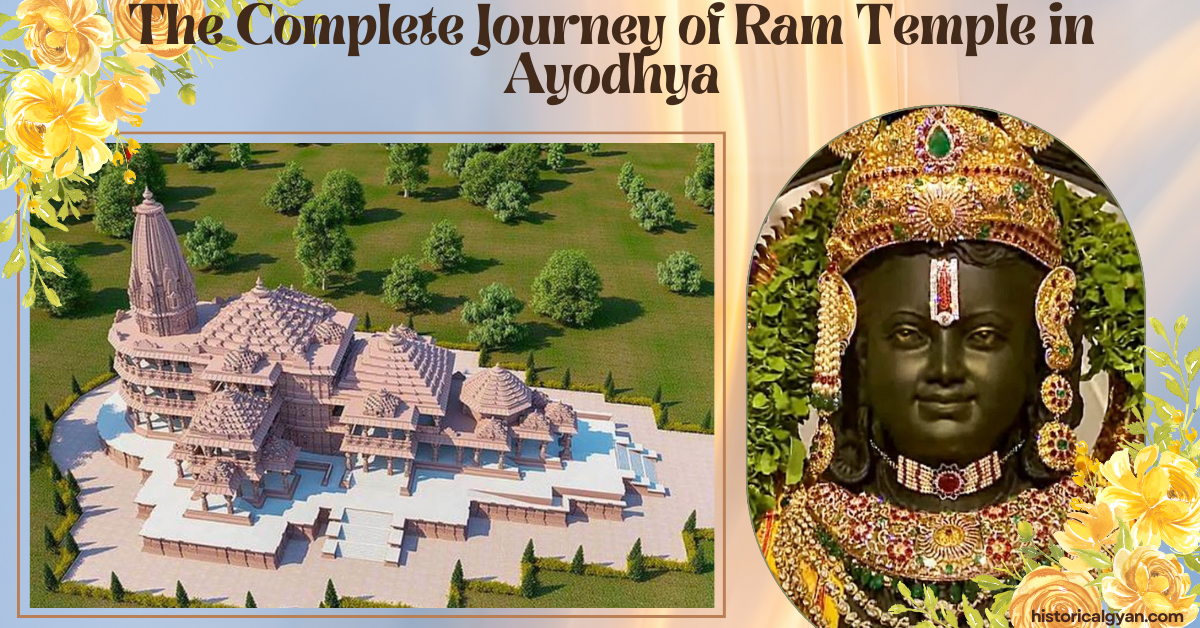Ram’s Birth and Exile

The Ramayana written by Maharishi Valmiki has been passed down through generations, it paints a vivid picture of Ayodhya as the capital of the Kosala Kingdom under the rule of King Dasharatha, the birth of Lord Rama, the father of Lord Rama, his exile and his victorious return to Ayodhya.
The Return Story
The Return Story Defeating the Demon King Ravan Deeply embedded in the cultural consciousness of India for millions of Hindus around the world, Ayodhya and Lord Rama are inseparable, the city is a living testament to the virtues of Lord Rama.

Ayodhya Across Eras
Ayodhya’s Origins
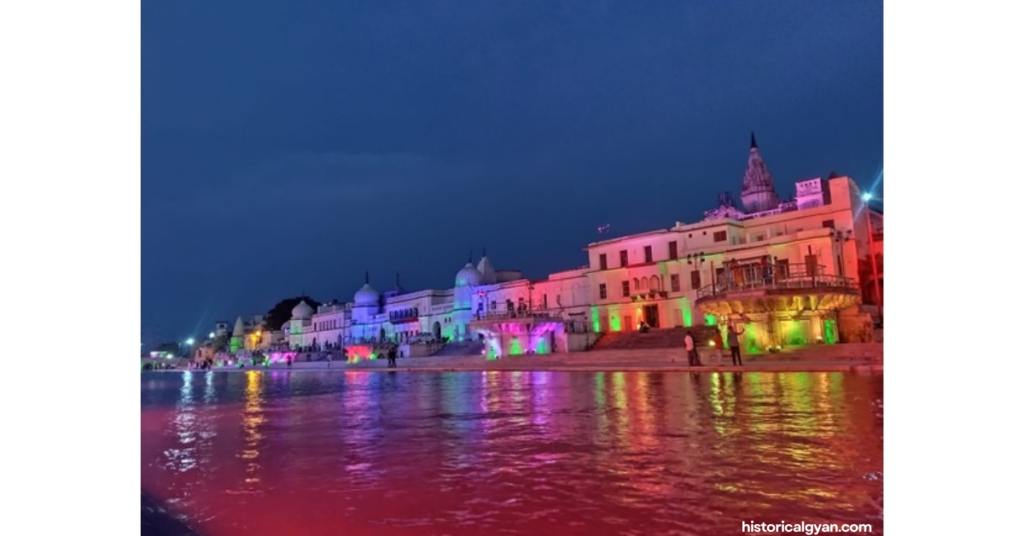
Turmoil and Revival
History of Ram Temple Ayodhya
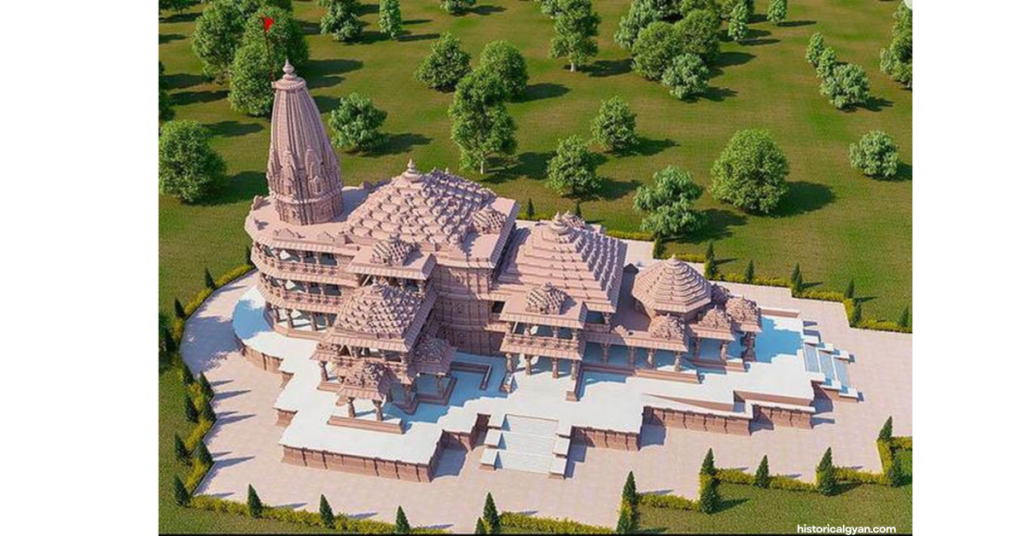
Actually, the history of the city of Ayodhya is older than Treta Yuga and it is believed that it is not possible for anyone to cover in words the entire history of Lord Shri Ram Janmabhoomi Temple located in Ayodhya and even if it covers its historical and legal importance to some extent. So it is impossible to save in words its unlimited religious and mythological beliefs and the facts related to them.
Still, here we have tried to cover every aspect about this holy temple in a few words. In today’s article, we will talk about the journey to the birthplace of Shri Ram, from his controversy to demolition, construction and inauguration. Let’s start with the journey till
Ancient Foundations: Maharaj Kush and the Stone Pillar Temple
The history behind the Ram Temple is deeply woven into the religious and cultural fabric of India. According to Hindu mythology, Ayodhya is considered to be the birthplace of Lord Ram in the epic Ramayana. It remained here for many years after Lord Shri Ram moved to Baikunth Dham along with his subjects. The land remained lying like this, later King Kush of Kaushambi re-established Ayodhya.
Its description is found in Kalidas’s book ‘Raghuvansh’. According to ‘Lomash Ramayana’, he was the first to build a temple with stone pillars on the revered birthplace of his great father.
King Vikramaditya’s Stewardship and Temple Renovations
According to Jain traditions, Ayodhya was re-established by Rishabh Dev. According to ‘Bhavishya Purana’, King Vikrama Ditya of Ujjain rebuilt the ruined Ayodhya for the second time in BC. According to religious texts, he was a great devotee of Lord Vishnu and he built Ayodhya on the Laxman Ghat of Saryu River as its base.
He had constructed 360 temples and also constructed a grand temple at Shri Ram Janmabhoomi. The kings after Vikramaditya also took care of the Ayodhya Ram temple from time to time.
One of those kings, Pushyamitra Shunga, the first ruler of the Shunga dynasty, had also got the Ayodhya Ram temple renovated during his time. An inscription of Pushyamitra has also been found from Ayodhya in which there is a description of him performing two Ashwamedha Yagya in Ayodhya. Records were found in the excavation done to know the history of Ayodhya Ram Temple.
Ayodhya as a Trade Center
Chinese monk Fa-hien
The Chinese monk Fa-hien has also described the existence of many Buddhist monasteries along with the Ayodhya Ram temple. Chinese traveler Hien Tsang also came here in the seventh century. According to him, 20 Buddhist temples were present here. Where 3000 monks lived and there was also a major and very grand Ayodhya Ram temple for Hindus. Where thousands of people used to come every day to have darshan.
According to the evidence obtained after this, when King Jaichand of Kannauj came to rule in the 11th century AD, he had uprooted the inscriptions praising Emperor Vikramaditya from the Ayodhya Ram temple and got his name written on them. Jaichand also met his end after the battle of Panipat.
Challenges and Resilience: Attacks and Invasions
Mughal Rule and Controversies
Evidence
Aurangzeb’s Reign and Demolition
Post-Mughal Period and Struggles for Reconstruction: 18th to 20th Century
After this, from time to time, movements continued for the construction of a temple at this place. However, the disputed location of its construction at the alleged birth place of Lord Ram created long-term religious and cultural conflicts. For the first time during the rule of 1853, riots took place in the areas around Ram Temple and Babri Masjid.
In 1859, to stop this dispute, the British allowed Muslims to worship inside the structure and Hindus to worship on Ram Chabutra. Besides, the British and the British Administration also erected a fence between these two places to separate them and avoid any dispute among the devotees.
First petition of Ram temple

For the first time in 1885, Mahant Raghubir Das filed a petition in the Faizabad court regarding the construction of a temple on the platform near Babri Masjid, which was rejected by the court. In 1934, once again a situation of Commune Rights arose in Ayodhya and Shahjahanpur in which this mosque was damaged. Also happened. But later this mask was repaired once again.
In this series, in 1944, the Commissioner of Sunni Waqf declared the land of Babri Masjid as Sunni property. He said that Babar was a Sunni Muslim, hence this land comes under the Waqf Board.
Descent of the idol of Ramlala
India became independent in the year 1947 and after sometime on 23 December 1949, there was once again a tremendous turn in the history of Ram Janmabhoomi temple. That day the statue of Ramlala was suddenly found sitting inside the mosque. This controversy grew so much that ultimately the then government had to consider that structure as controversial and get it locked.
The prayers inside the structure stopped but the prayers continued outside at the Ram Chabutra and in the rest of the complex. And from here this controversy became more vocal with each passing year.
Legal battles ensued (1950–1961)
From the year 1950, a legal battle started over the then disputed premises. Gopal Visharad and Ramchandra Das filed two applications in the Firozabad Civil Court for permission to worship Ramlala inside the structure and to allow his statue to remain there. In 1959, Nirmohi Akhara also filed a third application. In response, in 1961, the UP Sunni Waqf Board filed an application to take possession of the disputed site and remove the statues from inside the structure.
But time passed and applications continued to be filed. In the subsequent decades, the 1980s began with memories of the Emergency and the first non-Congress government formed for a short period of time, and from this decade onwards, this issue remained of great importance in the history of the country’s politics.
Political scenario in the 1980s
In 1980 itself, Jan Sangh and a faction of Janata Party came together and laid the foundation of Bharatiya Janata Party. Since then, the last 40 years of the party have been very turbulent regarding the viewpoint of Hindutva.
Atal Bihari Vajpayee was the first president and right from the beginning in 1980, Vajpayee had made Ram Janmabhoomi an issue. In fact, at the place where Babri Masjid was situated, earlier the RSS movement was going on for the independence of Ayodhya Ram birthplace. Which BJP linked to the concept of Hindutva in majority based politics.
There were two main reasons behind BJP getting very little success in the 1984 elections. One is BJP’s soft Hindutva and second is Congress getting sympathy due to Indira Gandhi’s assassination. Congress got a huge majority of 414 seats in the Lok Sabha.
Unlocking history (1986–1989)
Tension increased at the end of the 20th century because only 25 years later, in 1986, on the petition of UC Pandey, Faizabad District Judge KM Pandey, in a historic judgment of 1 February 1986, ordered the removal of the lock from the disputed structure and allowed Hindus to worship. Also gave.
Later, in August 1989, Allahabad High Court took over the title suit from Faizabad District Court and ordered to continue worship on the disputed land. In November 1989, the then Rajiv Gandhi government laid the foundation stone near the disputed land of Vishwa Hindu Parishad. Gave permission.
Due to this, the enthusiasm of BJP and Hindu organizations reached its peak. But the country and especially North India was engulfed in communal violence.
According to one figure, 800 people lost their lives in communal violence. BJP raised the issue of Ram Temple in the general elections of 1989 and VP Singh’s government was formed with the support of BJP with 85 seats. To capitalize on this enthusiasm, in September 1990, the then BJP President Lal Krishna Advani organized Shri Ram Rath Yatra and gave a new turn to the Ram Mandir Janmabhoomi movement.
Let us know what happened-
The Turning Point: Babri Demolition
Mandal Commission, Politics of Kamandal: Early 1990s
The Rath Yatra and Communal Tensions: 1989-1990

In September 1990, Vishwa Hindu Parishad Rashtriya Swayamsevak Sangh and Bharatiya Janata Party launched a campaign to build a Ram temple at the Ram Janmabhoomi site. The situation took a serious turn when BJP leader Lal Krishna Advani took out a Rath Yatra from Somnath to Ayodhya. A large crowd followed him. And within no time a large group was moving towards the disputed site.
VP Singh’s government at the Centre, which was running with the support of BJP, wanted to stop Advani’s visit at any cost. On the other hand, BJP had decided that in case of stopping the Rath Yatra, support would be withdrawn from the government. VP Singh was also aware of this very well but history had decided its role.
The Saffron Wave in Delhi
On 14 October 1990, the country’s capital was witnessing a new kind of politics. Whose color was saffron. Saffron colored flags waving in the hands, saffron stripes on the forehead and slogans of Ram on the lips. When Advani’s chariot passed from Connaught Place, the heart of Delhi, it seemed… Delhi should not be Delhi but a city of some mythological story. The scene of Ram Rath Yatra in Delhi.
After that, for the first time the Sangh Parivar realized that Ayodhya was the issue. Which can unite the Sangh Parivar which is scattered on the basis of issues. Meanwhile, on October 18, Lal Krishna Advani reached Bihar by train. Late night between Delhi and Bihar, a different script was being written on the political hotline.
Political Chess: VP Singh vs. Mulayam Singh Yadav
VP Singh understood the equation of politics and he did not want the credit for stopping the chariot to go to the then UP Chief Minister Mulayam Singh Yadav. VP Singh wanted to keep the reins of UP politics in his hands. But Chief Minister Mulayam Singh Yadav decided to fail the procession. And announced complete lockdown in the state.
There was tension in the air on 30 October 1990. Because the police had banned all bus and train services to Ayodhya. But this had no effect on the kar sevaks. They reached there on foot and some swam and crossed the Saryu river.
The disputed structure was cordoned off and as per the ‘Labour Han Commission’ report, 28,000 personnel of Uttar Pradesh Provincial Armed Constabulary were deployed in Ayodhya.
Ayodhya Lockdown: Clash of Forces
It was around 10 in the morning. When a large group of Kar Sevaks led by Vamdev Mahant Nritya Gopal Das and Vib’s Ashok Singhal moved towards the spot. When the police tried to stop them, a clash broke out.
After about an hour, a sadhu succeeded in hijacking that police constable bus. In which all the arrested kar sevaks were kept. He broke the barricades with the bus and started running towards the mosque. Kar sevaks on foot also started running behind the bus. Seeing this, the police force got a big shock and they started chasing about 5000 Kar Sevaks.
After this the saffron flag was hoisted over the Babri Masjid and then the tragedy happened. On the orders of the government, the police force opened fire on the crowd. Five people were killed in the firing. Many people died due to head injuries. There was a stampede on Saryu bridge. In which more people were also killed.
Tension Mounts in Ayodhya
After this incident, once again on 2 November, the Kar Sevaks moved towards Babri Masjid. And then there was a clash; the police tried to disperse the crowd by using tear gas and lathi charge. Some Kar Sevaks managed to reach the mosque and partially damaged it. Police opened fire for the second time in 72 hours.
Kar Sevaks were chased in the streets and many Kar Sevaks were killed by the police. Kothari Brothers were also involved in this. Who were allegedly dragged out of a house.
Later Mulayam Singh Yadav described the firing order as painful but necessary. Because the High Court had ordered to maintain peace, law and order until the verdict.
Meanwhile, the stakes of politics changed again and along with the Centre, the government of Uttar Pradesh also changed. PV Narasimha Rao’s government was formed at the Centre. Mulayam Singh lost the elections in UP and Kalyan Singh’s government was formed. The matter got worse day by day and many meetings took place. There were debates but no solution was found in any meeting.
Demolition of Babri Masjid: December 6, 1992
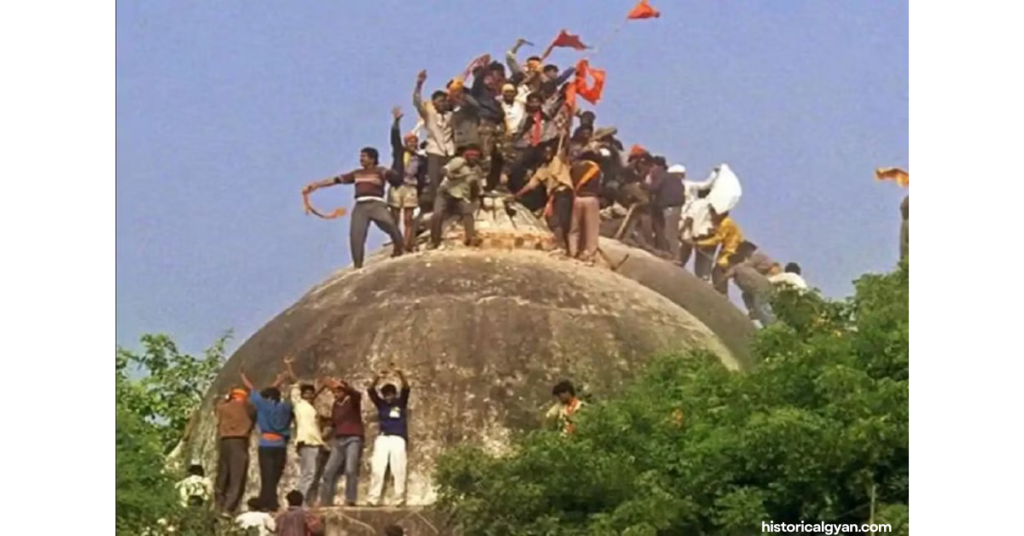
By December 5, the stage of religion along with politics was once again staged in Ayodhya. Everyone was waiting for the next morning. On 6 December 1992, an important turning point came. When RSS and its allies organized a rally of 150000 VHP and BJP Kar Sevaks at the disputed site.
When the crowd became restless, leaders like Advani, Murali Manohar Joshi and Uma Bharti gave speeches. Around noon a young man managed to break through the cordon and climbed the Babri Masjid and waved the saffron flag. This was seen as a signal by the mob who then stormed the Babri Masjid.
The number of police cordons deployed for the security of Babri Masjid was very high. But the number of uncontrollable crowd was also more than them. The mob attacked the building with an ax and hammer. Within a few hours, the Babri Masjid made of mud and square was demolished. This incident of destruction created an important chapter in the history of modern India.
Aftermath: Communal Strife Grips the Nation

As a result of this incident, the entire country was engulfed in the fire of widespread communal violence. Strained relations arose between religious communities. Many cities of UP including Mumbai, Surat, Ahmedabad, Kanpur, Delhi, Ayodhya were hit by violence.
According to a report, about 2000 people were killed in these riots. Nearly 900 people were killed in Mumbai alone. Mumbai was shaken in response to Ayodhya. And the human body became a mass of gunpowder.
On March 12, 1993, about 350 people were killed and about 1000 people were injured in 13 serial bomb blasts one after the other. India felt the pain of serial blasts for the first time. With this, a long series of legal battles started over the ownership of the disputed site.
Various parties including Hindu and Muslim groups presented their claims. Due to which a long legal process took place, the path of politics hurt the hearts and it changed both the direction and condition of the country.
Legal battle for Ram Temple
Allahabad High Court Decision
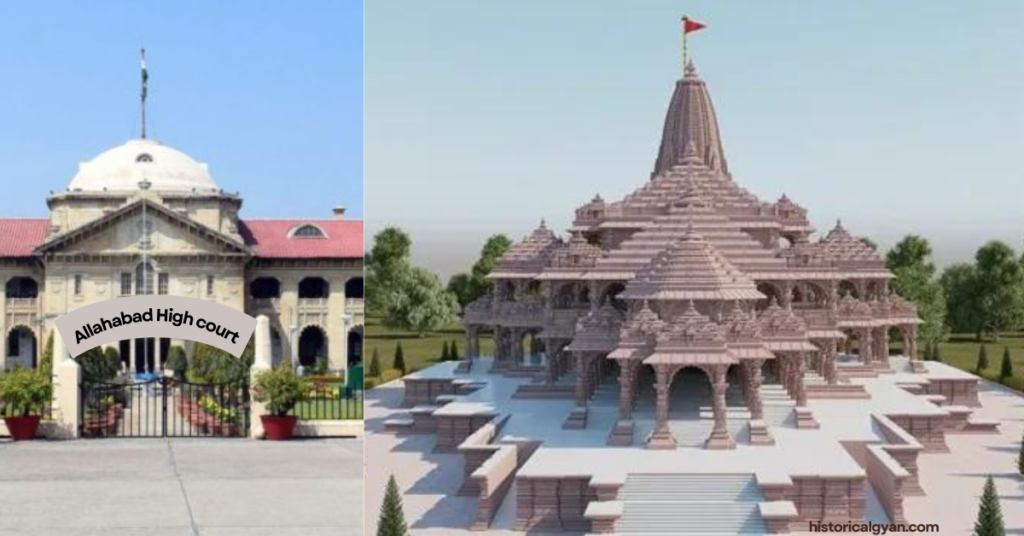
From April 2002, Allahabad High Court started hearing on the ownership rights of the disputed land. On September 30, 2010, the Allahabad High Court, by a majority decision of two judges, ruled to divide the disputed property among the three claimants.
One third share including Janmabhoomi was given to Hindus, one third was given to Nirmohi Akhara and the third was given to Muslim parties. In May 2011, the Supreme Court stayed the High Court’s decision after considering several petitions. In later years, efforts for mediation were also made under the supervision of the Supreme Court. But no solution to the dispute was found.
Ultimately, the five-member Constitution bench of the Supreme Court led by the then Chief Justice Ranjan Gogoi, after a marathon hearing of 40 days, reserved its decision on this decades-old legal dispute on 16 October 2019.
Supreme Court’s Historic Verdict

Inauguration and Architectural Plans
And then the grand construction work of Ram temple started. The construction of Ram temple started with the auspicious ground breaking ceremony held on 5 August 2020. The event marked the formal beginning of the construction of the temple and was attended by various religious leaders, political figures and dignitaries.

The ceremony included rituals and prayers. In which emphasis was laid on the sanctity of the land and divine blessings were sought for the successful completion of the temple. The architectural plans of Ram Temple show a blend of traditional and modern design elements.
The temple has been envisioned as a grand structure. Which has intricately carved domes and spires. The design takes inspiration from ancient Indian temple architecture. Particularly emphasizes the style prevalent in the North Indian Nagara tradition. Arun Yogiraj created the idol of Ram Lala for the Ram temple in Ayodhya, skilled artisans and craftsmen bring this vision to life. Ensuring that the temple is a testament to the rich cultural heritage of India.
Conclusion
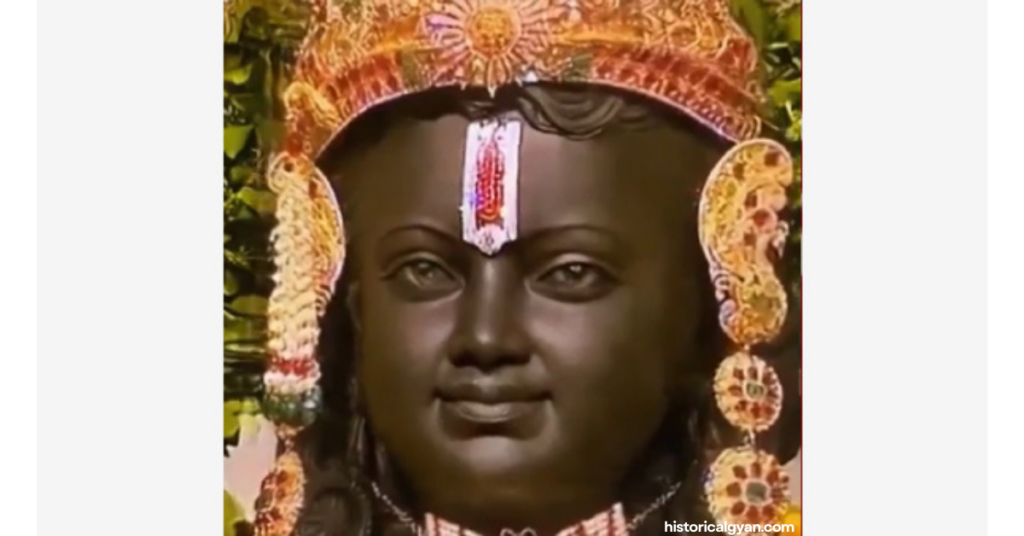
Meticulous preparations were made for the construction of the Ram temple and welcoming of devotees at the site. Underlining the importance of this moment in the country’s history, Prime Minister Narendra Modi played a central role in the inauguration ceremony. To make this moment historic, great personalities from all over the world arrived here to attend the ceremony. We hope that you too would have witnessed this historic moment.
